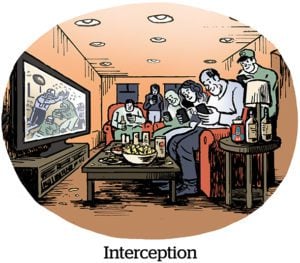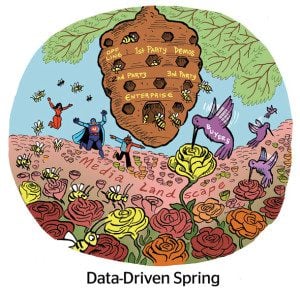Paramount is a powerhouse engine of consumer culture.
Ray-Ban aviator sales are through the roof thanks to the success of Paramount’s “Top Gun” sequel. And the Paramount show “Yellowstone” has helped flood Montana with wealthy home buyers, for some reason.
But Paramount hasn’t profited from sunglass sales or Montana real estate.
“We create the culture, those moments that impact commerce,” Paramount SVP of Advertising Leo O’Connor told AdExchanger. “Our fans have been trained, for better and worse, to be exposed to [a product or idea] in our content and then go look for it somewhere else.”
To be fair, Paramount isn’t expecting credit for driving a property sale in Montana. But there is an opportunity to better capitalize on the popularity of its shows.
Enter Shopsense AI. Paramount has been a flagship client since the company, which creates storefront extensions for TV broadcasters, launched in stealth mode last year. Shopsense’s main offering is to add a QR code or another call to action to a show so that someone watching can be directed to a shoppable landing page inspired by specific shows on their phone.
Now, Shopsense and Paramount are going a step further with the introduction of Magnite as an SSP partner. Previously, Shopsense and Paramount ad placements were only available through direct deals. With Magnite, these product placements will be open to programmatic buyers for the first time.
“A critical part of what we like about the Shopsense product is that it allows us to keep [audiences] inside our ecosystem,” O’Connor said.
The shoppability problem
Shopsense placements work within live, linear feeds, streaming subscription services and practically anything that plays on a TV screen. Apple TV or Roku, for example, can’t block a broadcaster from placing a QR code or a bar on the bottom of the screen directing viewers to check out a commerce site.
But shoppable TV can also feel a bit like trying to make fetch happen.
The CBS daytime talk show “The Talk,” which was an early test case for Shopsense’s second-screen stores, involved anchors and other talent on the show prompting viewers to check out the shops by following the links.
“This is a behavior that we need to teach our fans to adopt,” O’Connor said.
But there is some skepticism as to whether consumers will ever learn.
 Take QR codes, which continue to plug away, mostly in obscurity, although they’ve caught on some with young viewers, according to Bryan Quinn, Shopsense’s president and co-founder. Shopsense embraces QR codes as well as practically any call to action that might get a TV viewer to a mobile shopping page.
Take QR codes, which continue to plug away, mostly in obscurity, although they’ve caught on some with young viewers, according to Bryan Quinn, Shopsense’s president and co-founder. Shopsense embraces QR codes as well as practically any call to action that might get a TV viewer to a mobile shopping page.
Some platforms, meanwhile, are pushing for the remote as a potential hub as the way to grow shoppable TV. But people watching live shows or especially sports aren’t going to pause to start shopping, Quinn said. Which is why Shopsense is all in on the smartphone as the shoppable TV chain.
Quinn is former director of Amazon Publisher Services, and he oversaw audio advertising for Alexa devices and shoppable ad units for Fire TV. In other words, he’s keenly aware of both the opportunity and how hard it is for new kinds of shopping ad units to take off.
“The great news is that no one’s better at raising awareness than broadcasters, who have been doing it for decades,” he said.
Retail TV media
The shoppable TV trend is closely following the rise of retail media.
Paramount, for instance, has a comprehensive deal with Walmart that gives Walmart+ members a free subscription to the Paramount+ with Ads streaming service. Walmart is also the first retailer partner in Paramount and Shopsense’s pilot program.
But, although retail media and shoppable TV are related, O’Connor said, “they’re both parts of a bigger strategy to do whole-funnel marketing with Paramount.”
Viewers aren’t going to stop and click through an ad to do their grocery shopping while they’re in the middle of streaming a show, he said. But products can easily be added to a basket for later.
Just like how “Top Gun” helps sell aviators, Paramount shows (and ads) can inform everyday grocery decisions. “Being able to better target and measure those folks is what we’re going after with the retail media piece of it,” O’Connor said.
Programmatic ad buys via Shopsense generate more data and targeting for the advertiser, Quinn said, since most retail media budgets are currently transacted through walled gardens like Amazon.
Working with Magnite, brands can bring their DSP of choice and attribute or target Shopsense ad placements across Paramount shows within their usual measurement program, he said.
There are very few other places on the web where streaming TV or video viewers are really “in shop mode” and also aren’t stuck inside walled garden platforms, Quinn said.
According to O’Connor, Paramount is now far down the path in pursuit of an answer to its hypothesis, “that our content drives commerce.”
Fashion companies, cereal makers, online travel agencies – every TV advertiser knows that awareness on-screen leads to traffic and interest in stores, he said.
But what if the new storefront is a person sitting on their couch and scrolling their phone?
“We want to figure out how we can tap into this in a bigger way,” O’Connor said.

















